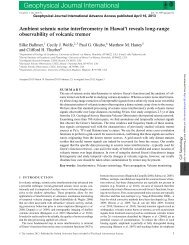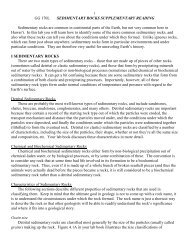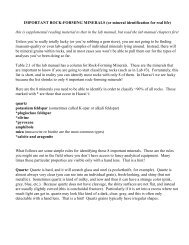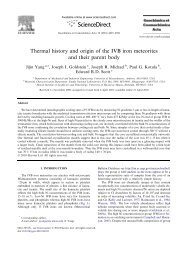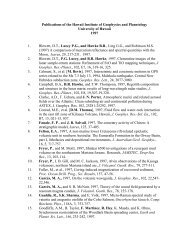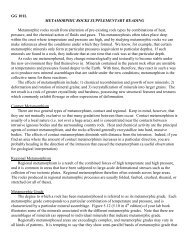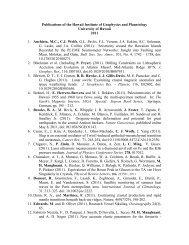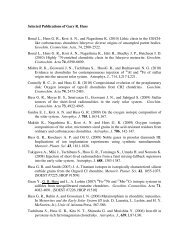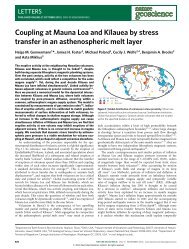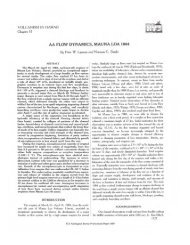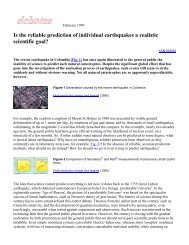Topographic Maps and Digital Elevation Models
Topographic Maps and Digital Elevation Models
Topographic Maps and Digital Elevation Models
You also want an ePaper? Increase the reach of your titles
YUMPU automatically turns print PDFs into web optimized ePapers that Google loves.
Chapter 6 <strong>Topographic</strong> <strong>Maps</strong> <strong>and</strong> <strong>Digital</strong> Elevaton <strong>Models</strong> III<br />
o -------------.-----------------------------..------- .. --------..--------.---------------------------.----------------------------.-----------------.------------------------------------.--------------------------.----------------.-------------------------<br />
55-----------------------------------------------------.-.--...---- ..-.....----- ..--- ....-------------------------------------------<br />
C\J -------------.--••••••••-•• -••• -.-.-.---------.-------••• --------.-------•• -------- •• -------•• -------- •• --------.-------- •• --------.-------- •• ------ •• ------- •• --------.-- ----- •• --------.-------•• --------.--------.--------.-------•••• -------.-------<br />
o ---- --- ------.--------.-.-- - --.--.- -.---- - ----- -..---........... ----.- - -------.--- - ---- .<br />
8- ---.-------------..--.------ -..------------------------------------------------------------------------------------------------<br />
C\J ••••••••••••••••••-•••••••••••••••••••••••••••••••••••••••••••••••••••••••-.---.---.--••••••••-•• -••• ----------------.--•• ----. --------.--------.-.------.-------- •• ------- •• --- •• -••• --------. --------•• -- •••••••• -•••••• ----------------••••••••-.-••• --<br />
o<br />
55 .......---------------------------------------------------'<br />
~A<br />
A'<br />
FIGURE 6.16<br />
Blank graph for constructing the topographic profile of Problem 2. The vertical axis marks feet above sea level.<br />
f. Being a developer of taste <strong>and</strong> refinement, you'd like to put your name in 20-foot-tall neon letters on the top of Brousseau<br />
Mountain. But will your guests be able to see your name from the lodge dining area to be located at point X on the map? To<br />
find out, construct a topographic profile along the line A-A' on Figure 6.15. To save time, use just the index contours except<br />
when marking the elevations of hilltops <strong>and</strong> valley bottoms. Draw your profile on the graph provided (Fig. 6.16). Label<br />
"Brousseau Mountain," "Great Averill Pond," <strong>and</strong> "Black Brook" on your profile. Draw a 20-foot letter on Brousseu<br />
Mountain <strong>and</strong> see if there is a direct line of sight from point X (the future dining room) to the letter.<br />
Will the guests be able to see your name in lights?<br />
What is the vertical exaggeration on the profile you drew? Show your work.<br />
3. Comparing a contour map with a DEM: Figures 6. J7 <strong>and</strong> 6.18 show the area around Mono Lake, CA. Use these figures to<br />
answer the questions that follow.<br />
a. Determine some basic facts about the map (Fig. 6.17):<br />
The contour interval is 200 feet. In low-relief areas, such as in Mono Valley, they have inserted supplementary contours<br />
(dashed). What is the elevation difference between a supplementary contour <strong>and</strong> an adjacent regular contour?<br />
Older USGS maps often emphasize the Township <strong>and</strong> Range grid system; newer maps often emphasize the UTM grid.<br />
What is the name for the areas outlined by the red squares, which are marked by such labels as R27E <strong>and</strong> T3 ?<br />
About how many miles separate adjacent red lines on this map?<br />
<strong>Maps</strong> of western states frequently show many mines (most are small <strong>and</strong> ab<strong>and</strong>oned) <strong>and</strong> many springs. Draw the symbols<br />
for mines <strong>and</strong> springs as shown on this map:<br />
Why might mappers of western states be concerned with showing every spring they find?<br />
b. Because I:250,000 maps cover a lot of area, their contours tend to show only larger features. The USGS sheets also tend to<br />
be cluttered <strong>and</strong> difficult to read. In contrast, the OEM of Figure 6.18 clearly shows even subtle l<strong>and</strong>scape features. The<br />
OEM image was compiled from a series of OEMs derived from the st<strong>and</strong>ard USGS 7Y,-minute topographic quadrangle<br />
maps. Comparison of Figures 6.17 <strong>and</strong> 6.18 makes obvious two advantages of OEMs: They are free of non-l<strong>and</strong>scape



